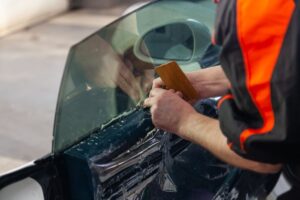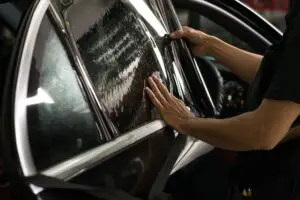The window tint laws in Colorado have been active and have been updated since 1995 and exist to allow law enforcement to easily identify the driver and the people inside the vehicle.
These laws control how much light can go into your car.
The crux of Colorado window tint laws has a non-reflective and 70% VLT tint windshield that is limited to the top 4 inches of the windshield.
The rest of the windows must allow a minimum of 27% VLT, which is true for all types of car and their windows, excluding the windshield.
I will go over these laws in greater detail, so make sure that you read the article in its entirety to get the most out of it.
Table of Contents
- 1 How Much Tint Darkness Is Legal In Colorado?
- 2 Window Tint Reflection And Tint Colors
- 3 Medical Exemption Of Window Tint Laws In Colorado
- 4 Get A Certified Sticker From The Company
- 5 Other Window Tint Law Rules And Regulations In Colorado
- 6 Cost Of Car Window Tint In Colorado
- 7 Frequently Asked Questions
- 8 Conclusion
How Much Tint Darkness Is Legal In Colorado?

27% VLT seems to be the sweet spot for the legal tints in Colorado, where VLT is the light that is supposed to enter the vehicle through the windows.
The higher the VLT, the lighter the tint on the windows. Low VLTs make it difficult for officers to identify the people inside the car. That is why these laws exist.
Tint Darkness Limit For SUVs And Vans
Some states like to have different rules for sports utility vehicles and vans, but others like to keep all the rules the same for all cars.
This is the case for the state of Colorado, which has the same rules for vans and SUVs as it does for sedans.
All windows, the front seat side windows, the rear windows, and the back seat side windows all must have 27% VLT at the minimum, where any less can get you an infraction.
The tint of the windshield can only be on the first 4 inches of the windshield to not impair the driver’s visibility.
This tint must be non-reflective and capable of letting in at least 70% light to further retain visibility.
Tint Darkness Limit For Sedans
As was the case for sports utility vehicles and vans, sedans also have the same rules, which I will go over in this section of the article and explain per window.
1. Front Windshield
Speaking of the front windshield, it needs to have a VLT of 70. The tint itself cannot be reflective and must only be on the top 4 inches of the front windshield itself.
2. Front Seat Side Windows
The front-seat side windows must allow at least 27% light into the car, and this sets the baseline for all other windows except the windshield.
3. Rear Window
Going back to the rest of the windows, the rear windows continue the front seat side windows trend by requiring more than 27% VLT.
4. Back Seat Side Windows
Finally, the back seat side windows also follow this pattern are require the user to have at least 27% of the light pass through the windows.
Window Tint Reflection And Tint Colors
- The front-seat side windows of all vehicles, SUVs, vans, and sedans cannot have tints that have mirrored or metallic aesthetics.
- This is similar to the back seat side windows, which also cannot have mirrored and metallic tints. This is true for all car types.
- Mirrored and metallic tints can cause distractions for other drivers and make it next to impossible to identify who or what is inside, which is probably why they are not allowed in most states.
- Colored tints are allowed by the state of Colorado, but a few colors are not allowed and are considered illegal
- These colors include:
– Red
– Amber
Medical Exemption Of Window Tint Laws In Colorado

While many states are considerate of the people who have certain conditions that prevent them from staying in the sun for too long, the state of Colorado does not recognize any sort of illnesses, physical or mental, to allow for any medical exemptions.
This means that regardless of your condition and the medical opinions surrounding it, you can only have the tints that have 27% VLT.
Even if you have a medical letter or application, it will not be acceptable by the state of Colorado, and hence, you will have to abide by the rules set by the state at all times.
Medical exemptions are not a thing in Colorado when it comes to window tints, which is extremely inconvenient for people with skin cancer or other conditions affected by UV light.
If you have a medical condition, the most you can do is get the lowest VLT level tint possible in the state or think about moving to a different state entirely.
Get A Certified Sticker From The Company
Not having any medical exemptions regarding window tint laws may be quite annoying and inconvenient for some users, but at least you are not required to have or display any certifications or stickers related to the legibility of your window tints.
The manufacturers are not required to issue a certificate that states that their products are legal in Colorado.
As the owner of a tinted window car, you are not required to have a sticker showing that the window tints are following the standards set by the state.
This convenience is greatly appreciated by the people and would have been perfect if the state had allowed for medical exemptions.
Other Window Tint Law Rules And Regulations In Colorado
I have explained the main laws up till now. It is time I discuss the other laws that depend on the tint of your windows.
- If your back windows are tinted, you will need dual-sided mirrors.
- You are not required to have any certification or stickers for your window tints.
- You cannot be medically exempt from the laws set by the state when it comes to window tints.
Cost Of Car Window Tint In Colorado
The costs of tinting your windows in Colorado can range from decent to expensive, with the standard and cheapest tint window tints costing as low as $120.
The average cost of a standard window tint is usually $150.
If you want to opt for better quality window tints, you should be willing to pay as high as $800, which becomes absurd. Some tints can even go as high as $1000.
The factors that affect these prices can be the quality, durability, and the color that you may choose, so make sure you think long and hard about what type of tint you want for your car windows.
Frequently Asked Questions
Q1. Is 15% Tint Legal In Colorado?
Since the state requires at least 27% VLT in all windows, it is clear that 15% of tints are not legal in Colorado. You should try your best to follow the 27% rule that the state has set.
Q2. Are 5% Tints Legal In Colorado?
As I have discussed above, the minimum amount of VLT required by each window is 27%. 5% is too low in the face of these requirements, so 5% tints are not legal in this state either.
Q3. Is Limo Tint Legal In Colorado?
Limo tints are generally extremely dark, generally having very low VLT and blocking out a lot of light.
That is why they are not legal in the state of Colorado. All windows must allow at least 27% VLT.
Q4. Can I Get Pulled Over For Tint In Colorado?
If an officer suspects that you are using tints that are darker than they should be or are using illegal colors, then you can be pulled over.
The officer will inspect your tint and act accordingly.
Q5. How Much Is A Tint Ticket In Colorado?
Illegal tints are a Class B traffic violation in the state of Colorado and hence carry a heavy fine. This can be bumped up to a misdemeanor which can cost you anywhere from $300 to $500.
Conclusion
Colorado tint laws are very relaxed for the most part however not offer the same level of convenience as other states do, particularly due to the fact that people who suffer from certain conditions cannot apply for a medical exemption, despite requiring no proof of the legibility of the window tints and their darkness.
These people will have to make do with the VLT levels set by the state.
Now that you have read the article, you should be able to do the same and avoid the heavy fines that come with the infractions of having too dark window tints or illegal colors.

I am Tahir Azam, and I have been writing amazing articles for TaxiHack for as long as I can remember. I know everything that is to know when it comes to automobiles and is always on top of industry news and developments. While I am not an expert by any means, I pride myself on knowing the ins and outs of many different problems and, of course, their solutions. The articles on our website are some of the best and well-researched content that you will find, and I spend countless hours making sure this remains to be true. This is why I ask you to take your time out and read some of my articles, especially if you find a topic that resonates with you or is something you are looking into. This way, you will find the perfect mix of information and tips on your desired topic. Learn more about Tahir.




